Top Of The Table: Pathfinder Adventure Card Game
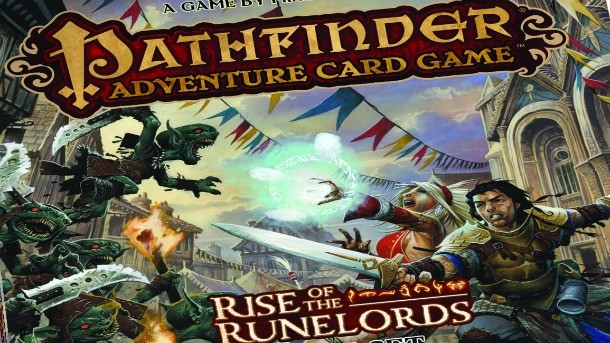
One of the most exciting things about following tabletop games is having a front row seat to the constant innovation unfolding in modern game design. New RPGs, card, dice, and board games are releasing all the time, and every year we see big surprises that offer fresh ideas that in turn help to fuel next year’s ideas.
The Pathfinder Adventure Card Game (designed by Mike Selinker) is one of those titles that sparks the imagination with its approach to gameplay and story. Drawing on the classic traditions of tabletop role-playing games, the Pathfinder card game sees a cooperative party of adventurers working together to delve into dungeons, travel to towns, and vanquish villains. Over time, your characters level up, acquire better equipment, and return for new stories and adventures. However, unlike classic RPGs like D&D (or the Pathfinder RPG, for that matter), no game master is required.
Getting Started
The core release of the Pathfinder card game is the Rise of the Runelords base set, which includes nearly 500 cards and a set of polyhedral dice that can be easily organized into a smartly appointed box inset. That’s important, because the numerous card types would get unwieldy without designated spots for each.
This initial Rise of the Runelords set is enough to keep you busy for many games, but the game is ultimately structured to be expanded over time. Like new modules of a role-playing campaign, new adventure deck packs periodically release that add new storylines, villains, and treasure into the mix for the party to confront. Each pack is meant to be added in sequentially, gradually increasing the power level of both the monsters and equipment as your characters level up over the course of many game sessions.
The forward-minded box inset also includes slots to place these expansion decks as they arrive, so that you can keep everything together in one box.
Pre-game card setup is a bit of a chore the first few times you do it. Each time you play, you choose a particular scenario. Multiple scenarios make up an adventure, and multiple adventures make up an adventure path, which is akin to a whole campaign. Each scenario dictates specific villain and location cards that must be placed out on the table, and each of the locations has a certain number of monsters, items, and other discoveries to be found there. In addition, the first time you play, you need to choose a character from an initial group of seven named heroes and build their custom deck of allies, spells, weapons, and other equipment. In other words, expect to do a good bit of rifling through and shuffling card decks before the action gets going.
Like any game setup, this process gets faster every time you do it, and it’s worth noting that in most cases your character decks will persist between sessions, so that step is only required your first time out. Thankfully, once everything is laid out and organized, game turns are quick, and scenarios play out in short order.
[Next Up: How the game is played]
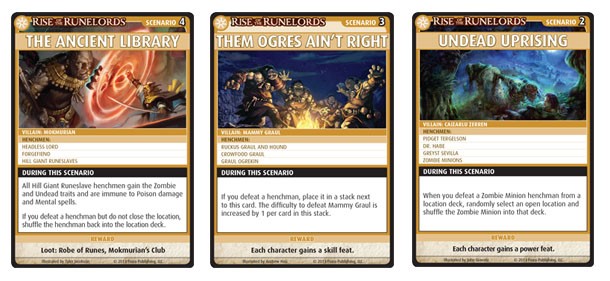
Gameplay
An individual scenario challenges the player to explore each of the locations on hand and uncover the villain (or villains) hiding away inside one of the decks. As they explore, players acquire new cards that represent new powers or items, fight monsters, attempt to elude traps, and confront other conflicts and barriers to progress, each represented by a card drawn from the location they visit. Eventually, opportunities arise to close off a location, making it safe from future evil. Find and defeat the villain, and the bad guy attempts to flee to one of the other nearby open locations, so it’s essential to block off his or her escape routes by closing up other locations first. Corner the villain in time and the party wins; take too many turns to do so, and the villain enacts his evil plan, and the party fails the scenario. The villains and locations lend a great sense of fantasy adventure to the experience, and offer meaningful context to the actions you’re taking as the game progresses.
Each turn, individual encounters arise in which you attempt to acquire new items or defeat monsters, enabled by a simple but fun sequence of playing cards and rolling dice. Players draw from their customized character deck to acquire a hand of cards, and then spend those cards to get bonuses on their dice rolls.
To acquire or defeat a card, you test one of your skills against a target number, but the die you roll is determined by your class. If you’re controlling the fighter, your strength die is extremely high, but your wisdom might not be so hot. To maximize your chance at success, cards played by you and your allies offer boosts or even additional dice to roll to get you closer to the target number. However, you have to be careful. Your card deck is also representative of your health; discard too many cards to get awesome bonuses, and you risk your character dying before the scenario is complete.
I love the cooperative risks and rewards that this system engenders. Do you spend an extra blessing card to help your buddy defeat that skeleton, or save it for your own turn? Should you exhaust additional cards to explore deeper into a dungeon, or save them for a future conflict? Players are involved not only on their own turn, but also engaged with other player’s actions, since everyone will win or lose together.
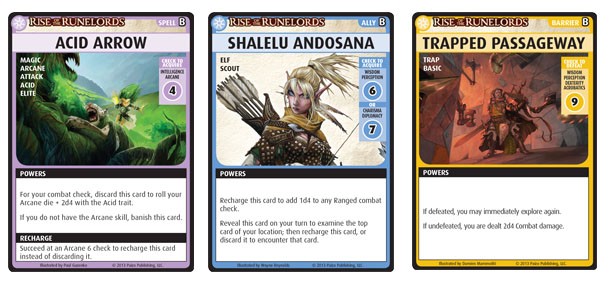
Theme And Story
The Rise of the Runelords set is based on a well-loved Pathfinder RPG campaign of the same name, and echoes the characters and story beats of that story. Players familiar with the RPG narrative can delight at the appearance of familiar heroes and foes, but new players get to experience the story for the first time.
In a broader sense, the Pathfinder Adventure Card Game is a triumph of mixing storytelling with solid card game mechanics. By organizing the game into a sequential series of encounters and adventures, players gain an appreciation for the unfolding narrative. Moreover, since you can maintain your character between adventures, players gain the same connection to their hero that you see in a role-playing game.
The storytelling is supported by gorgeous fantasy art, especially the iconic character art of fantasy artist Wayne Reynolds. While much of the card game’s art has been repurposed from the Pathfinder role-playing game, its use here gives the art new purpose, and brings the scenarios to life.
While a card game like this will never offer the flexible choices and player-driven narrative that a true RPG can provide, the sense of an ongoing story and persistent characters is hard to beat without a game master running things across the table.
[Next Up: What sort of gaming groups and families would enjoy the Pathfinder card game? And how much does it cost?]
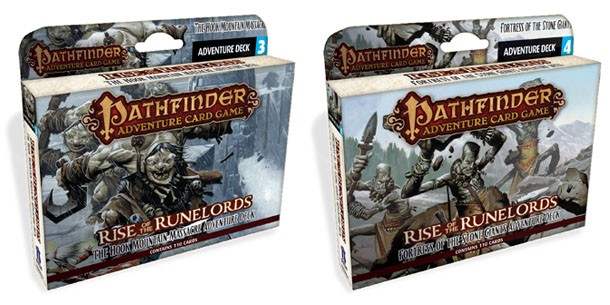
Complexity
The basic dice rolling mechanic is as simple as could be, making this a great option for introducing new players to an understandable and straightforward system. Since the game is cooperative, more experienced players can help by making suggestions of when to play cards or not, and several of the classes are built to support other heroes with healing and combat aid.
Even so, the ease of the basic mechanics doesn’t translate to an easy game. On the contrary, all of my multiple sessions playing through scenarios were nail-biters, and the villain beat us more than once. Players should be prepared for failure and occasional scenario replays as they attempt to progress the story.
After my initial sessions, I find myself looking forward to seeing the monsters and weapons awaiting in future decks. Each successful scenario and adventure results in new reward cards, or sometimes fundamental upgrades to your character’s skills and powers, like a better die to roll on a certain skill check. The further you play, the more you can customize your loadout, so one player’s cleric at the end of the adventure path will likely be very different from another player’s cleric, even though they both started with the same named hero.
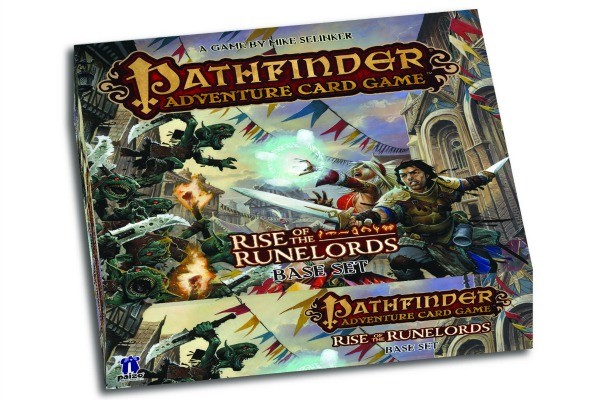
What Else Do I Need To Know?
The Pathfinder Adventure Card Game base set runs for $59.99 at retail, but several online retailers list the game for between $40 and $50. A character add-on deck adds a number of new cards as well as four additional character classes to choose from, including the monk, druid, barbarian, and paladin, and that set has an MSRP of $19.99, or around $13 to $16 online. If you plan to play through the whole story, be aware that each subsequent adventure deck also runs around that same price under $20.
You can purchase directly from Paizo, but we also recommend online retailers like Cool Stuff Inc and Amazon. Alternately, stop in to your local hobby and game store; if they don’t have the Pathfinder Adventure Card Game in stock, they can likely order it for you.
This card game is an ideal fit for gaming groups and families looking for a long-term and highly replayable game that they can return to for session after session. If you plan to play the full Rise of the Runelords story, make sure and factor the cost of all six expansion decks into your decision-making, but be aware that even the base set of characters and adventures is enough to fuel some great fun. This is also a fantastic choice for groups who love role-playing games, but the time investment and prep involved (especially for the game master) is just too much to handle. No matter the composition of your group, my time with the Pathfinder card game revealed a tightly balanced and smartly executed system that I expect we’ll see emulated for years in other genres and styles.
If cooperative card games aren’t your thing, you might want to check out one of our previously featured tabletop games, including Ascension, Tannhauser, Castle Ravenloft, Yomi, Star Trek: Fleet Captains, Agents of SMERSH, A Touch of Evil, Mage Wars, The Adventurers: Pyramid of Horus, Dixit, Star Wars: Edge of the Empire. or Lords of Waterdeep.

Get the Game Informer Print Edition!
Explore your favorite games in premium print format, delivered to your door.
- 10 issues per year
- Only $4.80 per issue
- Full digital magazine archive access
- Since 1991









